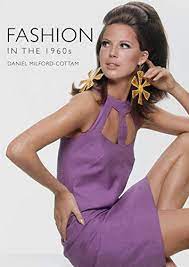The Iconic Sixties Fashion: A Blast from the Past
The swinging sixties was a decade that revolutionised fashion and style, leaving an indelible mark on the industry that is still felt today. The era was characterised by bold, vibrant designs, innovative silhouettes, and a sense of freedom and self-expression that had never been seen before.
One of the most iconic trends of the sixties was the mini skirt, popularised by British fashion designer Mary Quant. This daring style challenged traditional notions of femininity and became a symbol of female empowerment. Paired with colourful tights and Go-Go boots, the mini skirt epitomised the youthful exuberance of the decade.
Men’s fashion in the sixties also saw significant changes. The mod subculture emerged, with its sharp tailoring, slim-fitting suits, and bold patterns. The Beatles were at the forefront of this trend, influencing a generation of young men to embrace a more flamboyant and experimental approach to dressing.
Accessories played a crucial role in sixties fashion. Oversized sunglasses, statement jewellery, and headscarves were all popular choices that added a touch of glamour to any outfit. The beehive hairstyle was another hallmark of the era, with its towering height and intricate structure becoming synonymous with sixties style.
Prints and patterns were everywhere in sixties fashion. From psychedelic swirls to geometric shapes, designers embraced bold motifs that reflected the spirit of experimentation and rebellion that defined the decade. Colourful paisley prints and op-art designs were particularly popular choices for both clothing and home decor.
As we look back on the iconic fashion trends of the sixties, it’s clear that this era continues to inspire designers and fashion lovers alike. The spirit of innovation, creativity, and individuality that defined sixties style remains as relevant today as it was over fifty years ago.
Swinging Styles: Exploring the Iconic Fashion Trends of the Sixties and Their Enduring Legacy
- What were the key fashion trends of the sixties?
- How did the mini skirt become popular in the sixties?
- What influence did celebrities have on sixties fashion?
- Why was the mod subculture significant in shaping sixties style?
- What role did accessories play in sixties fashion?
- Which hairstyles were popular in the sixties?
- How did prints and patterns contribute to the style of the sixties?
- Why is sixties fashion still influential today?
What were the key fashion trends of the sixties?
The key fashion trends of the sixties were a vibrant reflection of the era’s cultural revolution. From the iconic mini skirt popularised by Mary Quant to the sharp tailoring and bold patterns of the mod subculture, the decade was defined by a sense of experimentation and self-expression. Accessories such as oversized sunglasses and statement jewellery played a crucial role in completing the look, while prints like psychedelic swirls and geometric shapes added a touch of whimsy to outfits. The sixties were a time of bold colours, daring silhouettes, and a spirit of innovation that continues to inspire fashion trends to this day.
How did the mini skirt become popular in the sixties?
The mini skirt’s rise to popularity in the swinging sixties can be attributed to the innovative vision of British fashion designer Mary Quant. In the mid-1960s, Quant introduced this daring and revolutionary style as part of her collection, challenging traditional hemlines and redefining notions of femininity. The mini skirt quickly captured the spirit of youth culture, offering a bold and liberating fashion statement that resonated with women seeking self-expression and empowerment. Embraced by iconic figures such as Twiggy and Jean Shrimpton, the mini skirt symbolised a shift towards modernity and individuality in fashion, ultimately becoming a timeless symbol of the dynamic and progressive era that was the sixties.
What influence did celebrities have on sixties fashion?
Celebrities played a significant role in shaping sixties fashion, serving as trendsetters and style icons for the masses. From the elegant sophistication of Audrey Hepburn to the rebellious edge of The Rolling Stones, celebrities of the era influenced everything from haircuts to hemlines. Icons like Twiggy popularised the mod look with her pixie haircut and doe-eyed charm, while Brigitte Bardot epitomised French chic with her effortless yet glamorous style. The Beatles’ sharp suits and mop-top hairstyles became synonymous with mod culture, inspiring a generation to embrace a more tailored and polished aesthetic. Overall, celebrities in the sixties not only reflected the fashion trends of the time but also helped to define and shape them, leaving a lasting legacy that continues to inspire designers and fashion enthusiasts today.
Why was the mod subculture significant in shaping sixties style?
The mod subculture played a significant role in shaping sixties style due to its innovative approach to fashion and its influence on youth culture at the time. Characterised by sharp tailoring, slim-fitting suits, and bold patterns, mods rejected traditional norms and embraced a more flamboyant and experimental aesthetic. Icons like The Beatles popularised mod fashion, inspiring a generation of young people to adopt a style that reflected their desire for self-expression and individuality. The mod subculture’s emphasis on tailored clothing, attention to detail, and penchant for mixing high-end pieces with vintage finds contributed to the overall vibrancy and diversity of sixties fashion, leaving a lasting impact on the industry that continues to be celebrated today.
What role did accessories play in sixties fashion?
Accessories played a crucial role in shaping the iconic style of sixties fashion. From oversized sunglasses to statement jewellery and headscarves, accessories were key in adding flair and personality to outfits. The beehive hairstyle, a signature look of the era, was often complemented by bold accessories that enhanced the overall aesthetic. Whether it was colourful paisley prints, op-art designs, or geometric shapes, accessories in the sixties were a means of self-expression and a way to make a fashion statement. They added a touch of glamour and individuality to outfits, reflecting the spirit of experimentation and creativity that defined the era’s fashion landscape.
Which hairstyles were popular in the sixties?
During the swinging sixties, hairstyles played a pivotal role in defining the era’s iconic fashion trends. A variety of distinct hairstyles gained popularity during this time, reflecting the spirit of experimentation and individuality that characterised the decade. The beehive hairstyle, with its towering height and intricate structure, was a standout choice for women seeking a bold and glamorous look. Men often sported sleek, side-parted styles or embraced longer hair inspired by rock ‘n’ roll icons like The Beatles. The mod subculture also favoured sharp, geometric cuts and styled hair with precision to complement their tailored suits. Overall, the hairstyles of the sixties were diverse and reflected the era’s dynamic social changes and cultural influences.
How did prints and patterns contribute to the style of the sixties?
Prints and patterns played a pivotal role in shaping the distinctive style of the sixties fashion scene. The era embraced bold and vibrant motifs, from psychedelic swirls to geometric shapes, that symbolised the spirit of experimentation and rebellion that defined the decade. Colourful paisley prints and op-art designs were particularly popular choices, adding a dynamic and eye-catching element to clothing and accessories. These patterns not only reflected the era’s sense of freedom and self-expression but also captured the optimism and creativity that permeated sixties fashion. The use of innovative prints and patterns allowed individuals to make a bold statement with their clothing, showcasing their unique personality and embracing the spirit of change that defined this iconic period in fashion history.
Why is sixties fashion still influential today?
The enduring influence of sixties fashion can be attributed to its revolutionary spirit and timeless appeal. The era marked a significant shift in the way people approached style, embracing bold designs, innovative silhouettes, and a sense of freedom and self-expression. The iconic trends of the sixties, such as the mini skirt, mod suits, and psychedelic prints, continue to resonate with contemporary fashion enthusiasts for their daring and forward-thinking nature. The spirit of creativity and individuality that defined sixties fashion remains a source of inspiration for designers today, ensuring that its impact on the industry endures through the decades.

